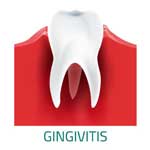
Smoking & Gum Disease
Smoking is a major risk factor for developing gum disease.
There is a strong link between smoking and gum disease. Compared to nonsmokers, people who smoke are four times as likely to develop periodontal disease, which is a severe form of gum disease.
During the early stages of gum disease smoking can accelerate the progression from milder gingivitis to periodontitis.. Furthermore, continuing to smoke while undergoing treatment for periodontitis can reduce a person's healing response by up to 50%.
Tobacco's harmful effects aren't limited to cigarette users: People who use smokeless tobacco, or who smoke cigars, or pipes, or use marijuana also face an increased risk of periodontal disease.
Smoking, Gum Disease, and Quitting
As individuals experience the effects of smoking, their gums may exhibit early signs of gum disease, such as redness, swelling, and bleeding. However, in some cases, nicotine can suppress these symptoms by constricting blood vessels while causing other types of damage, such as bone loss and periodontal pockets.
Smoking is just as bad for your teeth as it is for your gums. It discolors teeth, and if your gum disease progresses to periodontitis, your teeth may loosen and eventually fall out.
When it comes to oral health and smoking or other types of tobacco use, the best thing you can do is stop. Although quitting will not reverse previous damage, Combining it with good oral care practices can significantly slow the progress of gum disease should slow significantly. Moreover, your response to treatment will be similar to a nonsmoker.
Talk to your dentist to learn more about treatment options.
Improve Your Daily Oral Care Routine
Along with professional dental care, at-home practices can help mitigate the effects of gum disease. If you have periodontal disease due to current or former tobacco use, consider adding a WATERPIK water flosser to your daily oral care routine. Studies have shown that among people previously treated for periodontal disease, those who used a WATERPIK water flosser daily experienced less bleeding and gingivitis than those who did not.
After gum disease treatment, you may still have some periodontal pockets remaining. It is important to keep these pockets clean and healthy. Using a WATERPIK water flosser with the Pik PocketTM tip and a therapeutic mouth rinse can be highly beneficial. Learn more by reading or listening to our article Periodontal Pockets: Cleaning & Treatment.


